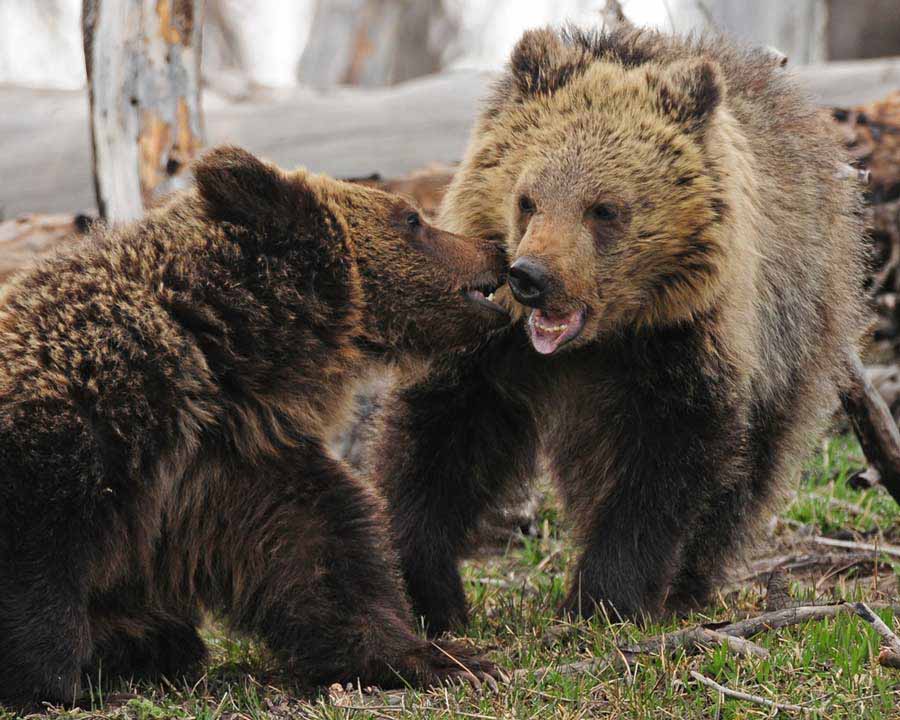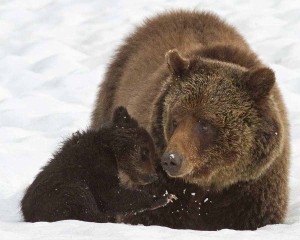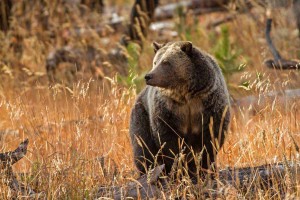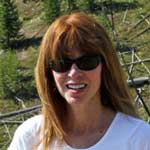
By Sandy Sisti
One of the highlights of any trip to Yellowstone National Park is getting a chance to watch grizzly bear cubs-of-the-year, or cubs born that year. Although you may see grizzly cubs-of-the-year at any time, the best season to view them is spring, just after they emerge from the den.
Grizzly cubs are born in the den during mid-January to early February, weighing a little less than a pound at birth. Subsisting on a diet of rich milk, cubs quickly gain weight and can tip the scales at up to 10 pounds when they exit the den with their mother.
The area between Yellowstone’s East Entrance and Fishing Bridge offers a great chance for viewing mother grizzlies with cubs. Yellowstone Lake is home to a thriving grizzly population, including a grizzly sow known as Blaze that has produce many cubs in her more than 15 years. Blaze is considered something of a matriarch of the Lake area grizzlies. Her numerous offspring include bears known to visitors and photographers by names like Circus Bear, Raspberry and White Claws.

I first had the pleasure of photographing Blaze with her two yearling cubs, Raspberry and White Claws, in 2008, when she spent most of the early spring foraging near Steamboat Point. She returned to the same area in May of 2009 with her then two-year-old cubs in tow. Normally in June of a cub’s second year, female grizzlies once again feel the desire to mate. It is at this time that female grizzlies separate from their cubs, who have depended on them since birth. So begins a very difficult time in the life of sub-adult grizzlies who no longer have the protection of their mother and must learn to survive on their own.
The mortality rate is high for these young bears and they are often relegated to habitat that larger, more mature bears find unsuitable, including areas near human activity. That was the case with Raspberry and White Claws, who were frequently seen foraging along roadsides after they separated from their mother.
In an unfortunate turn of events, White Claws was euthanized by the National Park Service in August of 2011, after reports that he had become an aggressive bear that was conditioned to human foods. On July 30, 2011, the Park Service reported that White Claws “aggressively approached and then charged at a man sitting along the Storm Point Trail on the north edge of Yellowstone Lake,” according to a statement released at the time by the Yellowstone public affairs office.
“The man threw his pack at the bear, which stopped the bear’s charge. However, the bear then tore into the man’s pack and ate the food inside,” park officials said.
This tragedy ended the life of White Claws, but his sister, Raspberry, who is now a healthy five-year-old, can often be seen foraging among the burned pines near Yellowstone Lake.

Once separated from Raspberry and White Claws, Blaze was again free to mate. She did not produce a cub in 2010, but in 2011, she gave birth to a single, dark cub-of-the-year. When Blaze and her tiny cub left the den in the spring, they were spotted with regularity near Blaze’s favorite vole hunting grounds between Indian Pond and Fishing Bridge.
The winter of 2010-11 was a heavy snow year, so Blaze and her cub often took advantage of the plowed roads around the lake to travel between her favorite haunts. As the snow began to recede and her cub began to grow larger, Blaze and her offspring were seen less frequently. When they were spotted again with regularity during autumn, they both looked plump, healthy and ready for hibernation.
During 2012, Blaze and her yearling cub could still be spotted around Yellowstone Lake, but not with the frequency they once were. Although the pair didn’t make too many appearances during 2012, Raspberry was seen more often around the lake area. In fact, during late May, Raspberry was observed to have mated with a male grizzly for the first time. This event has wildlife watchers eagerly awaiting next spring, with hopes that Raspberry will give birth to cubs of her own, adding another chapter to the story of the grizzlies of Yellowstone Lake.
 Sandy Sisti is a wildlife and nature photographer based just outside the east entrance of Yellowstone, in the heart of the greater Yellowstone ecosystem. Sisti is also an avid hiker who enjoys exploring Yellowstone’s backcountry. Her 2013 Yellowstone wildlife calendar is on sale now.
Sandy Sisti is a wildlife and nature photographer based just outside the east entrance of Yellowstone, in the heart of the greater Yellowstone ecosystem. Sisti is also an avid hiker who enjoys exploring Yellowstone’s backcountry. Her 2013 Yellowstone wildlife calendar is on sale now.
